That presents a challenge when we're writing poetry. The stillness, pause and "wait for it" drama you can create with a poetic line and line breaks -- not their natural skill set.
This week, we're trying Tanka. If you'd like to learn more about this ancient Japanese form, visit the Tanka Society of America. The form is popular with poets who favor the spareness of haiku, but want to extend beyond that moment-in-time image into metaphor or emotion.
My first attempt didn't go so well. The concept of five lines was difficult for some children to grasp, so the poems looked paragraphs.
I put my teaching cap on and created a frame. The new lesson works like this:
The children are in small groups of two or three (cooperative learning warm-up). I put a word up on the board: SNOW. We brainstorm all of the associations, feelings and images we can think of. No editing allowed! If I say "monster trucks," it goes on the brainstorming. Maybe my family goes to see the monster truck show every winter.
Next I give each group a word: bird, grass, shell, moon. They do the brainstorming activity on their own. We might share a few with the class after five minutes.
We spend about 15 minutes reading and discussing sample tanka. We try counting syllables, although I tell them the syllables needn't be exact. I explain the upper and lower poem -- a challenging concept that we can continue to work on in later drafts.
And here is the tanka frame, with a student's brainstorming and initial poem filled in.
 Much better! I love how this student captures the mixed emotions a powerful animal can give us. Check back for more third grade tanka tomorrow. There is a lesson on teaching students how to create line breaks here.
Much better! I love how this student captures the mixed emotions a powerful animal can give us. Check back for more third grade tanka tomorrow. There is a lesson on teaching students how to create line breaks here.


No comments:
Post a Comment